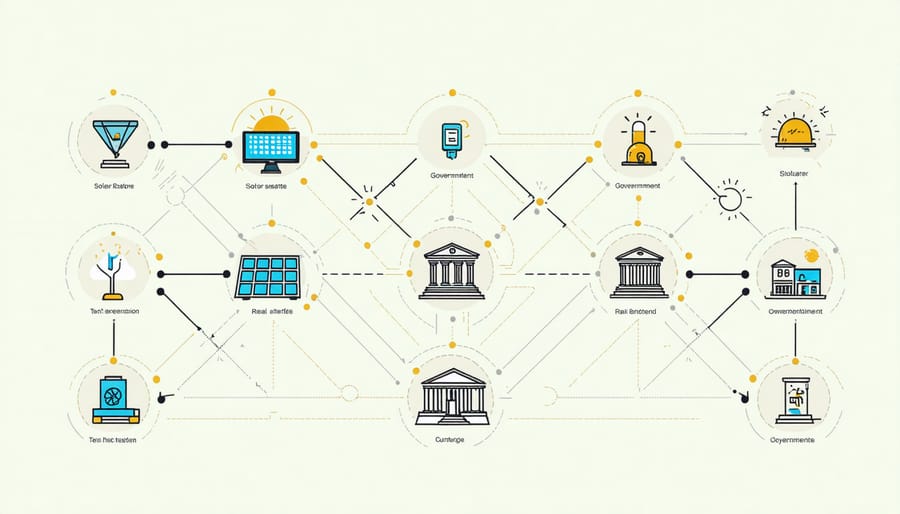Cross-sector collaboration has become a cornerstone of modern industrial growth, transforming modern business through strategic partnerships that drive innovation and sustainability. By combining resources, expertise, and market access across public, private, and nonprofit sectors, organizations are achieving unprecedented breakthroughs in renewable energy adoption and technological advancement.
Industry leaders who embrace cross-sector partnerships report 40% faster project implementation and 35% higher ROI compared to traditional single-sector approaches. These collaborations create powerful synergies: governments provide regulatory support and infrastructure, private companies contribute technical expertise and capital, while research institutions deliver cutting-edge innovations and validation.
Forward-thinking organizations recognize that the complex challenges of sustainable energy development cannot be solved in isolation. Through structured partnerships, shared risk management, and collaborative funding models, cross-sector initiatives are accelerating the deployment of renewable energy solutions while creating new market opportunities and economic benefits for all stakeholders.
The convergence of diverse sector capabilities has become essential for addressing the scale and complexity of modern energy challenges, making cross-sector collaboration not just beneficial, but imperative for sustainable growth and competitive advantage in today’s interconnected business landscape.
The Power of Strategic Partnerships in Solar Development

Key Players in Solar Collaboration
The solar industry’s collaborative landscape is shaped by four primary sectors working in strategic alignment. Utility companies serve as cornerstone partners, providing grid infrastructure and managing power distribution networks. They frequently partner with technology manufacturers who supply photovoltaic panels, inverters, and smart monitoring systems.
Financial institutions play a crucial role by offering specialized funding mechanisms, including power purchase agreements (PPAs), leasing options, and green bonds. These funding solutions enable project development and scale-up operations across markets.
Government entities and regulatory bodies contribute through policy frameworks, incentives, and renewable energy standards. Their involvement helps create market stability and encourages private sector participation. Additionally, research institutions and universities partner with industry players to advance solar technology and improve efficiency.
Construction and engineering firms complete the ecosystem by providing expertise in project implementation, while energy consultants bridge knowledge gaps between sectors. This multi-stakeholder approach has proven effective in accelerating solar adoption and creating sustainable energy solutions that benefit all participants.
Synergy Benefits
Cross-sector collaboration creates powerful synergies that drive innovation and efficiency across participating organizations. When businesses, government agencies, and research institutions work together, they combine distinct competencies, resources, and perspectives to achieve outcomes that would be impossible in isolation.
These partnerships typically yield multiple benefits: cost reduction through shared resources, accelerated research and development cycles, and enhanced market penetration. Organizations gain access to complementary expertise, specialized equipment, and established networks while spreading risks and reducing individual capital requirements.
For example, when manufacturing companies collaborate with research institutions, they can leverage academic expertise for product innovation while providing real-world testing environments. Similarly, public-private partnerships often result in streamlined regulatory processes and improved policy frameworks that benefit entire industries.
Financial advantages also emerge through economies of scale, shared infrastructure costs, and improved funding opportunities. Furthermore, cross-sector collaboration often leads to knowledge transfer, capability building, and the development of industry best practices that elevate overall sector performance and competitiveness.
Real Estate and Solar: A Powerful Partnership

Commercial Property Integration
Recent case studies demonstrate the remarkable success of commercial solar integration across diverse business environments. The Mall of America’s implementation of rooftop solar panels exemplifies large-scale adoption, generating 1.2 megawatts of power while reducing annual operating costs by 40%. This project successfully brought together retail tenants, utility providers, and solar developers in a coordinated effort.
Similarly, Toyota’s manufacturing facility in Texas showcases effective cross-sector collaboration between automotive and renewable energy industries. The facility’s 7.75-megawatt solar installation powers 25% of its operations, achieved through partnership with local utilities and solar technology providers.
The Whole Foods Market chain demonstrates how retail businesses can leverage solar power across multiple locations. Their partnership with SunPower Corporation resulted in solar installations at 100 stores, reducing electricity costs by 25% per location. The project’s success relied on collaboration between property management, energy consultants, and installation teams.
These implementations highlight how strategic partnerships between property owners, energy providers, and technology specialists can create sustainable, cost-effective solutions while maintaining operational efficiency. The key to success lies in careful planning, stakeholder alignment, and clear communication channels between all parties involved.
Property Value Enhancement
Solar installations have demonstrated a significant positive impact on commercial property values, creating multiple financial advantages for building owners and investors. Studies consistently show that properties with solar installations command premium valuations, with increases ranging from 3-8% compared to similar non-solar properties.
The enhancement in property value stems from several key factors. First, buildings with solar installations typically generate lower operating costs, making them more attractive to potential tenants and buyers. These reduced expenses translate into higher net operating income (NOI), a crucial metric in commercial real estate valuation.
Additionally, properties featuring solar installations often qualify for various green building certifications, such as LEED, which can further boost market value and attract environmentally conscious tenants. The presence of solar infrastructure also signals a property’s commitment to sustainability and future-readiness, increasingly important factors in commercial real estate decisions.
Recent market analysis reveals that commercial properties with solar installations experience shorter vacancy periods and stronger tenant retention rates. This improved occupancy stability contributes to more predictable cash flows and enhanced long-term asset value. Furthermore, as corporate sustainability commitments become more prevalent, properties equipped with solar technology are better positioned to meet evolving tenant demands and regulatory requirements.
Government and Private Sector Collaboration
Policy Framework Support
Government policies play a crucial role in fostering cross-sector collaboration within the solar industry. Regulatory frameworks, such as renewable portfolio standards (RPS) and investment tax credits (ITC), create favorable conditions for partnerships between private enterprises, public institutions, and research organizations. These policies provide financial incentives and reduce barriers to entry, encouraging diverse stakeholders to participate in solar energy development.
Many jurisdictions have implemented green energy mandates that require utilities to source a percentage of their power from renewable sources, naturally driving collaboration between utility companies and solar developers. Additionally, grant programs and public-private partnership initiatives help bridge funding gaps and distribute risk across multiple sectors.
Innovation clusters and economic development zones, supported by local and national policies, create geographic concentrations of interconnected companies, suppliers, and institutions. These policy-driven ecosystems facilitate knowledge sharing, resource optimization, and accelerated technology commercialization through strategic partnerships.
The success of these policy frameworks is evident in regions where multiple sectors actively contribute to solar industry growth, resulting in increased employment, technological advancement, and economic development.
Incentive Programs
Incentive programs play a crucial role in fostering cross-sector collaboration within the solar industry. Through innovative financing models, organizations can access shared funding pools, tax incentives, and performance-based rewards that make collaborative projects more financially viable.
Government-sponsored programs often provide matching funds for joint ventures between private companies and research institutions, while industry associations create pooled investment opportunities for member organizations. These mechanisms help distribute risk and maximize resource utilization across participating sectors.
Performance-based incentives encourage sustained collaboration by rewarding measurable outcomes, such as reduced carbon emissions or increased energy efficiency. Many programs also offer accelerated depreciation benefits and grant opportunities specifically designed for cross-sector initiatives.
Public-private partnerships frequently leverage these incentives to create sustainable funding structures, combining government subsidies with private capital to drive innovation and scale. This approach has proven particularly effective in developing comprehensive solar solutions that benefit multiple stakeholders while maintaining commercial viability.

Technology and Manufacturing Partnerships
Innovation Through Collaboration
Cross-sector collaboration has driven remarkable technological breakthroughs in the solar industry. The partnership between Tesla and Panasonic exemplifies this innovation potential, resulting in highly efficient solar cells and advanced energy storage solutions. Their joint venture at the Gigafactory has accelerated the development of integrated solar roof tiles and high-capacity batteries.
Another notable example is the collaboration between First Solar and engineering firms, which led to the development of thin-film photovoltaic technology that significantly reduced manufacturing costs while improving panel efficiency. The U.S. Department of Energy’s SunShot Initiative demonstrates how public-private partnerships can accelerate innovation, bringing together research institutions, manufacturers, and utilities to achieve breakthrough solar technologies.
The Microsoft-Invenergy partnership showcases how tech giants and renewable energy developers can create innovative solutions for data center power consumption. Their collaboration resulted in advanced energy management systems that optimize solar power integration with existing grid infrastructure.
These partnerships continue to drive down costs while pushing technological boundaries, making solar energy increasingly competitive and accessible across various sectors. The resulting innovations have helped overcome traditional barriers to solar adoption while creating new market opportunities.
Supply Chain Optimization
Cross-sector collaboration drives significant improvements in supply chain efficiency through shared resources, expertise, and infrastructure. When solar manufacturers, logistics providers, and technology companies work together, they create streamlined processes that reduce costs and accelerate delivery times. This supply chain innovation has led to remarkable improvements in inventory management, procurement strategies, and distribution networks.
By leveraging shared data platforms and integrated logistics systems, collaborating partners can better predict demand, optimize storage solutions, and coordinate transportation more effectively. For example, when solar panel manufacturers partner with raw material suppliers and shipping companies, they can implement just-in-time delivery systems that minimize warehouse costs while ensuring consistent product availability.
These partnerships also enable better risk management through diversified supplier networks and shared contingency planning. Companies can maintain business continuity during disruptions by accessing alternative supply routes and materials through their collaborative networks. This resilience, combined with reduced operational costs and improved delivery speeds, creates a compelling business case for cross-sector supply chain collaboration in the solar industry.
Future Outlook for Solar Industry Partnerships
The solar industry’s collaborative landscape is poised for significant transformation over the next decade, with emerging trends indicating a shift toward more integrated and diverse partnerships. Market analysts project that cross-sector collaborations will become increasingly crucial for scaling solar adoption and driving innovation in renewable energy solutions.
Several key trends are expected to shape future partnerships. First, the integration of artificial intelligence and IoT technologies will create opportunities for data-sharing collaborations between solar companies and tech firms, enabling more efficient system operations and predictive maintenance. Financial institutions are also expected to develop more sophisticated green financing products, making solar investments more accessible to businesses of all sizes.
Manufacturing partnerships are likely to evolve, with solar companies forming strategic alliances with traditional industrial players to optimize supply chains and reduce production costs. These collaborations will be particularly important as the industry works to meet growing demand while maintaining quality standards and addressing sustainability concerns.
Government-private sector partnerships are expected to become more sophisticated, moving beyond simple incentive programs to include comprehensive urban planning and infrastructure development initiatives. This evolution will be crucial for smart city development and grid modernization efforts.
Educational institutions and industry partners are projected to strengthen their relationships, focusing on workforce development and research initiatives. These partnerships will be essential for addressing the growing demand for skilled solar professionals and advancing technological innovations.
The future outlook also suggests an increase in cross-border collaborations, particularly in emerging markets, as companies seek to expand their global reach and leverage diverse expertise. These international partnerships will be vital for accelerating solar adoption in developing regions and creating more resilient supply chains.
Cross-sector collaboration represents a powerful catalyst for accelerating solar energy adoption and industry growth. By breaking down traditional barriers between businesses, governments, and research institutions, organizations can access new resources, share risks, and capitalize on complementary strengths. The evidence clearly demonstrates that collaborative approaches lead to more innovative solutions, reduced costs, and faster implementation of solar projects.
For business leaders considering their next strategic move, the time to explore collaborative opportunities is now. Whether through public-private partnerships, industry consortiums, or research collaborations, the potential benefits far outweigh the initial investment of time and resources. By embracing cross-sector partnerships, organizations can position themselves at the forefront of the renewable energy transition while creating sustainable value for all stakeholders.
Take the first step today by identifying potential partners and initiating conversations about shared objectives in the solar energy space. The future of sustainable energy depends on our collective ability to work together across sectors.

